View in other NatureServe Network Field Guides
NatureServe
Montana
Utah
Wyoming
Idaho
Wisconsin
British Columbia
South Carolina
Yukon
California
New York
Red-winged Grasshopper - Arphia pseudonietana
General Description
The following comes from Brooks (1958), Helfer (1971), Capinera and Sechrist (1982), Otte (1984), Vickery and Kevan (1985), McDaniel (1987), Pfadt (2002), Capinera et al. (2004), Brust et al. (2008), and Scott (2010). The body is large and dark brown to black, heavily speckled or with white markings on the head and pronotum. The dorsal disk of the pronotum (thorax) can be totally pale or straw-colored. The forewings (tegmina) are boldly speckled with black. The hind wings are bright red, margined with a broad black stripe with a long-pointed spur projecting toward the body, the upper outer tip can be transparent with black speckles or all black. The outer face of the hind femur is dark brown or black with a light ring at the tip near the knee. The inner face is blueish-black with light markings along the dorsal ridge and a light ring at the base near the knee. The hind tibia is also black with a light ring at its apex.
Communicative behavior/Crepitation* Qualitatively, communicative behaviors between the two Montana
Arphia species are similar, but there are some differences between them regarding stridulation*, crepitation and flight. Their flight displays are frequent, very conspicuous, and a common summer sight amid its habitats. Most flights are between 1-12 feet at heights of 3-12 inches. Both males and females crepitate in flight and when disturbed, with rates recorded to about 21-24 crepitations per second (compare with
Speckled Range Grasshopper,
A. conspersa). The crepitations are very loud and can be heard up to 300 feet away. They also stridulate and perform hind femur tipping and raising when on the ground during courtship and territorial displays (Otte 1970, and Pfadt 2002).
*
Crepitation is the sound produced by grasshoppers making a clicking or snapping noise with their wings when in flight, during courtship, territorial encounters or being disturbed.
*
Stridulation is rubbing one body part against another, usually the hind femur against the forewing in the case of the Band-winged Grasshoppers. This is often used for attracting a female during courtship (Otte 1970).
Phenology
This species overwinters in the egg stage. Eggs begin to hatch in mid-June, and continues for about 2 weeks, nymphs occurring on into mid-summer. Adults are present from mid-July into early November, depending upon timing of killing frosts (Capinera et al. 2004, and Scott 2010).
Diagnostic Characteristics
The following is taken from Brooks (1958), Helfer (1971), Capinera and Sechrist (1982), Otte (1984), Vickery and Kevan (1985), McDaniel (1987), Pfadt (2002), Capinera et al. (2004), Brust et al. (2008), and Scott (2010). The male body length is 20-25 mm, and female’s 25-37 mm (body lengths are variable). The length to end of forewing for males is 30-41 mm, and for female's, 32-47 mm. The median carina (ridge) of the pronotum is elevated, slightly arched longitudinally, and has a faint notch.
This species can possibly be confused with the
Speckled Range Grasshopper (
A. conspersa), as that species is usually found in the same habitats, but occurs earlier in the season as an adult and has usually disappeared in July (Pfadt 2002, Capinera et al. 2004, and Scott 2010).
Species Range
Montana Range
Range Descriptions
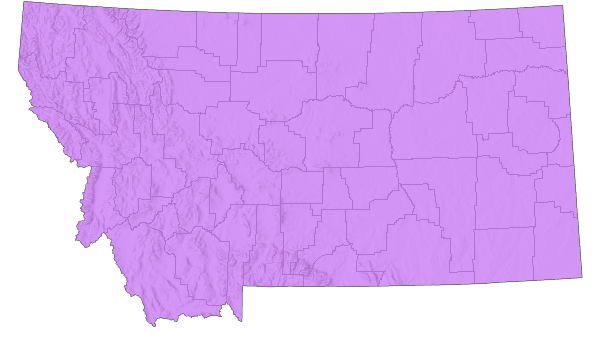
 Native
Native
Range Comments
The Red-winged Grasshopper has a wide range across western and mid-western states. From the inland areas of Washington, Oregon and California it extends eastward across northern Illinois, Indiana, Ohio, all of Michigan to southwest Ontario. From the north, in the southern regions of the western Canadian Provinces, it extends southward into the northern half of Mexico. This species reaches its highest densities in mixed-grass prairies. At the periphery of its geographical range, the species occurs in more restricted habitats and are less common and abundant. In Montana, it has been reported for 46 counties, but probably occurs statewide in suitable habitats (Otte 1984, Pfadt 2002, and Capinera et al. 2004).
Observations in Montana Natural Heritage Program Database
Number of Observations: 34
(Click on the following maps and charts to see full sized version)
Map Help and Descriptions
Relative Density
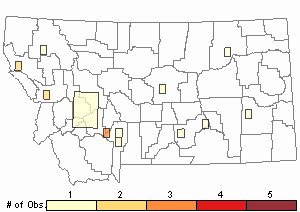
Recency
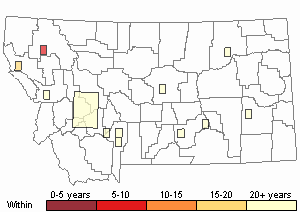

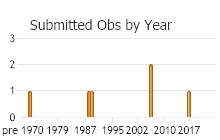
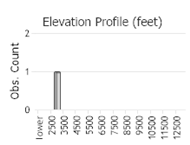 (Observations spanning multiple months or years are excluded from time charts)
(Observations spanning multiple months or years are excluded from time charts)
Habitat
This species inhabits forest openings, sagebrush steppes, grasslands, prairies (especially mixed-grass prairies), and prefers those with large areas of bare ground with sandy and gravelly soils (Otte 1984, Vickery and Kevan 1985, Pfadt 2002, Capinera et al. 2004, and Scott 2010).
Food Habits
The Red-winged Grasshopper primarily feeds on grasses and sedges. Observations indicate this species consumes about 20 species of grasses and 4 species of sedges. In a Montana mixed-grass habitat, a study revealed that Red-winged Grasshoppers fed on the green leaves of
Cheatgrass (
Bromus tectorum),
Western Wheatgrass (
Elymus smithii),
Blue Gramma (
Bouteloua gracilis),
Side-oats Grama (
Bouteloua curtipendula),
Needle-and-Thread (
Stipa comata), and
Green Needlegrass (
Stipa viridula). Sometimes they will feed on such forbs as
White Sagebrush (
Artemisia ludoviciana) and
Scarlet Globemallow (
Sphaeralcea coccinea) (Capinera and Sechrist 1982, Vickery and Kevan 1985, Pfadt 2002).
Reproductive Characteristics
The Red-winged Grasshopper’s courtship and copulatory sequences are similar to those of the
Speckled Range Grasshopper (
A. conspersa). The egg pods are nearly straight, about 48 mm long with the top 16 mm of the pod filled with froth, and contain 24-25 eggs. The eggs are tan or brown and are 4.2-5.2 inches long (Otte 1970 and 1984, Pfadt 2002).
Stewardship Responsibility
References
- Literature Cited AboveLegend:
 View Online Publication
View Online Publication Brooks, A.R. 1958. Acridoidea of Southern Alberta, Saskatchewan, and Manitoba (Orthoptera). The Canadian Entomologist (Supplement 9) 90:5-92.
Brooks, A.R. 1958. Acridoidea of Southern Alberta, Saskatchewan, and Manitoba (Orthoptera). The Canadian Entomologist (Supplement 9) 90:5-92. Capinera, J.L. and T.S. Sechrist. 1982. Grasshoppers of Colorado: Identification, Biology, and Management. Fort Collins, CO: Colorado State University Experiment Station, Bulletin 584S. 161 p.
Capinera, J.L. and T.S. Sechrist. 1982. Grasshoppers of Colorado: Identification, Biology, and Management. Fort Collins, CO: Colorado State University Experiment Station, Bulletin 584S. 161 p. Capinera, J.L., R.D. Scott, and T.J. Walker. 2004. Field Guide to Grasshoppers, Katydids, and Crickets of the United States. Ithaca, NY. Cornell University Press.
Capinera, J.L., R.D. Scott, and T.J. Walker. 2004. Field Guide to Grasshoppers, Katydids, and Crickets of the United States. Ithaca, NY. Cornell University Press. Helfer, J.R. 1971. How to Know the Grasshoppers, Crickets, Cockroaches, and Their Allies. Revised edition (out of print), Mineola, NY: Dover Publications.
Helfer, J.R. 1971. How to Know the Grasshoppers, Crickets, Cockroaches, and Their Allies. Revised edition (out of print), Mineola, NY: Dover Publications. McDaniel, B. 1987. Grasshoppers of South Dakota. Brookings, SD: South Dakota Agricultural Experiment Station, Bulletin TB 89.
McDaniel, B. 1987. Grasshoppers of South Dakota. Brookings, SD: South Dakota Agricultural Experiment Station, Bulletin TB 89. Otte, Daniel. 1970. A comparative study of communicative behavior in grasshoppers. Miscellaneous Publications, Museum of Zoology, No. 141. Ann Arbor, MI: University of Michigan.
Otte, Daniel. 1970. A comparative study of communicative behavior in grasshoppers. Miscellaneous Publications, Museum of Zoology, No. 141. Ann Arbor, MI: University of Michigan. Otte, Daniel. 1984. The North American Grasshoppers Volume II. Acrididae (Oedipodinae). Harvard University Press. 366 pp.
Otte, Daniel. 1984. The North American Grasshoppers Volume II. Acrididae (Oedipodinae). Harvard University Press. 366 pp. Pfadt, R.E. 2002. Field Guide to Common Western Grasshoppers, 3rd edition. Laramie, WY: Wyoming Agricultural Experiment Station, Bulletin 912, modified by S. Schell and S. Schell for electronic publication. Accessed 19 February 2020. http://www.uwyo.edu/entomology/grasshoppers/field-guide/index.html#fieldguidetoc
Pfadt, R.E. 2002. Field Guide to Common Western Grasshoppers, 3rd edition. Laramie, WY: Wyoming Agricultural Experiment Station, Bulletin 912, modified by S. Schell and S. Schell for electronic publication. Accessed 19 February 2020. http://www.uwyo.edu/entomology/grasshoppers/field-guide/index.html#fieldguidetoc Scott, R.D. 2010. Montana Grasshoppers, Katydids, and Crickets A Pictorial Field Guide to the Orthoptera. MagpieMTGraphics, Billings, MT.
Scott, R.D. 2010. Montana Grasshoppers, Katydids, and Crickets A Pictorial Field Guide to the Orthoptera. MagpieMTGraphics, Billings, MT. Vickery, V. R. and D. K. M. Kevan. 1985. The grasshopper, crickets, and related insects of Canada and adjacent regions. Biosystematics Research Institute, Ottawa, Ontario. Publication Number 1777. 918 pp.
Vickery, V. R. and D. K. M. Kevan. 1985. The grasshopper, crickets, and related insects of Canada and adjacent regions. Biosystematics Research Institute, Ottawa, Ontario. Publication Number 1777. 918 pp.
- Additional ReferencesLegend:
 View Online Publication
View Online Publication
Do you know of a citation we're missing? Anderson, N.L. 1951. Field studies on the biology of range grasshoppers of southeastern Montana. M.Sc. Thesis. Bozeman, Montana: Montana State University. 96 p.
Anderson, N.L. 1951. Field studies on the biology of range grasshoppers of southeastern Montana. M.Sc. Thesis. Bozeman, Montana: Montana State University. 96 p. Anderson, N.L. 1962. Grasshopper-vegetation relationships on Montana grasslands. Ph.D Dissertation. Bozeman, Montana: Montana State University. 73 p.
Anderson, N.L. 1962. Grasshopper-vegetation relationships on Montana grasslands. Ph.D Dissertation. Bozeman, Montana: Montana State University. 73 p. Bland, R.G. 2003. The Orthoptera of Michigan—Biology, Keys, and Descriptions of Grasshoppers, Katydids, and Crickets. East Lansing, MI: Michigan State University Extension, Bulletin E-2815. 221 p.
Bland, R.G. 2003. The Orthoptera of Michigan—Biology, Keys, and Descriptions of Grasshoppers, Katydids, and Crickets. East Lansing, MI: Michigan State University Extension, Bulletin E-2815. 221 p. Brust, M.L, W.W. Hoback, and R.J. Wright. 2008. The Grasshoppers of Nebraska. Lincoln, NB: University of Nebraska Extension Service, APHIS.
Brust, M.L, W.W. Hoback, and R.J. Wright. 2008. The Grasshoppers of Nebraska. Lincoln, NB: University of Nebraska Extension Service, APHIS. Cushing, W.J., R.N. Foster, K.C. Reuter, and Dave Hirsch. 1996-2000. Seasonal occurrence of common western North Dakota grasshoppers. Sydney, MT: USDA/ARS, IMP Handbook, Technical Bulletin #1809 Section VI.8.
Cushing, W.J., R.N. Foster, K.C. Reuter, and Dave Hirsch. 1996-2000. Seasonal occurrence of common western North Dakota grasshoppers. Sydney, MT: USDA/ARS, IMP Handbook, Technical Bulletin #1809 Section VI.8. Gillespie, R.L.1992. Dynamics of grasshoppers (Orthoptera: Acrididae) at a rangeland-crop interference. Ph.D. Bozeman, MT: Montana State University. 111 p.
Gillespie, R.L.1992. Dynamics of grasshoppers (Orthoptera: Acrididae) at a rangeland-crop interference. Ph.D. Bozeman, MT: Montana State University. 111 p. Hebard, M. 1928. The Orthoptera of Montana. Proceedings of the Academy of Natural Sciences of Philadelphia, Vol. 80:211-306.
Hebard, M. 1928. The Orthoptera of Montana. Proceedings of the Academy of Natural Sciences of Philadelphia, Vol. 80:211-306. Henry, J.E. 1969. Protozoan and viral pathogens of grasshoppers. Ph.D. Dissertation. Bozeman, MT: Montana State University. 153 p.
Henry, J.E. 1969. Protozoan and viral pathogens of grasshoppers. Ph.D. Dissertation. Bozeman, MT: Montana State University. 153 p. Kirk, K. and C.R. Bomar. 2005. Guide to the grasshoppers of Wisconsin. Madison, WI: Wisconsin Department of Natural Resources, Bureau of Integrated Science Services PUB-SS-1008. 154 p.
Kirk, K. and C.R. Bomar. 2005. Guide to the grasshoppers of Wisconsin. Madison, WI: Wisconsin Department of Natural Resources, Bureau of Integrated Science Services PUB-SS-1008. 154 p. Larson, D.P. 1996. Evaluation of sweep sampling as a method for determining grasshopper community composition on rangeland. M.Sc. Thesis. Bozeman, MT: Montana State University. 92 p.
Larson, D.P. 1996. Evaluation of sweep sampling as a method for determining grasshopper community composition on rangeland. M.Sc. Thesis. Bozeman, MT: Montana State University. 92 p. Mussgnug, G.L. 1972. The structure and performance of an adult population of Aulocara elliotti (Thomas) (Orthoptera, Acrididae) near Billings, Montana. M.Sc. Thesis. Bozeman, MT: Montana State University. 97 p.
Mussgnug, G.L. 1972. The structure and performance of an adult population of Aulocara elliotti (Thomas) (Orthoptera, Acrididae) near Billings, Montana. M.Sc. Thesis. Bozeman, MT: Montana State University. 97 p. Newton, R.C. and A.B. Gurney. 1956-1957. Distribution maps of range grasshopper in the United States. USDA Cooperative Economic Inst. Rep. 6 & 7.
Newton, R.C. and A.B. Gurney. 1956-1957. Distribution maps of range grasshopper in the United States. USDA Cooperative Economic Inst. Rep. 6 & 7. Richman, D.B., D.C. Lightfoot, C.A. Sutherland, and D.J. Ferguson. 1993. A manual of the grasshoppers of New Mexico. Las Cruces, NM: Cooperative Extension Service, Handbook No. 7.
Richman, D.B., D.C. Lightfoot, C.A. Sutherland, and D.J. Ferguson. 1993. A manual of the grasshoppers of New Mexico. Las Cruces, NM: Cooperative Extension Service, Handbook No. 7. Sater, S. 2022. The insects of Sevenmile Creek, a pictorial guide to their diversity and ecology. Undergraduate Thesis. Helena, MT: Carroll College. 242 p.
Sater, S. 2022. The insects of Sevenmile Creek, a pictorial guide to their diversity and ecology. Undergraduate Thesis. Helena, MT: Carroll College. 242 p. Skinner, K.F. 1995. Plant and grasshopper community composition: indicators & interactions across three spatial scales. M.Sc. Thesis. Bozeman, MT: Montana State University. 144 p.
Skinner, K.F. 1995. Plant and grasshopper community composition: indicators & interactions across three spatial scales. M.Sc. Thesis. Bozeman, MT: Montana State University. 144 p. Wachter, D.H. 1995. The ecology of selected grasshopper species along an elevational gradient. M.Sc. Thesis. Bozeman, Montana: Montana State University. 59 p.
Wachter, D.H. 1995. The ecology of selected grasshopper species along an elevational gradient. M.Sc. Thesis. Bozeman, Montana: Montana State University. 59 p.
- Web Search Engines for Articles on "Red-winged Grasshopper"
- Additional Sources of Information Related to "Insects"





